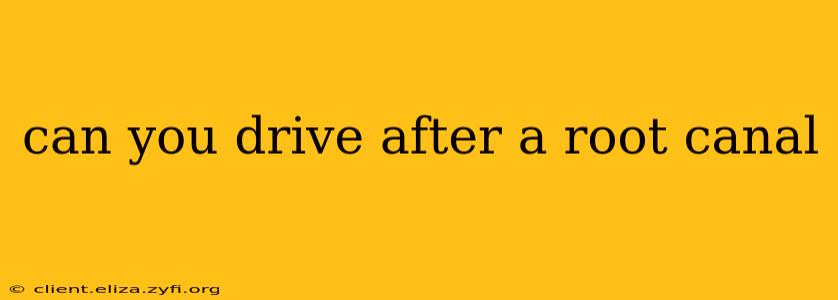Can You Drive After a Root Canal?
The short answer is: yes, you can usually drive after a root canal, but it depends on several factors. While a root canal itself doesn't directly impair your driving ability, the associated medication and potential lingering effects can influence your fitness to drive. Let's explore this further.
What Happens During a Root Canal?
A root canal involves removing the infected pulp from the inside of a tooth. This procedure typically requires local anesthesia to numb the area, making the procedure painless. After the procedure, you'll likely have some discomfort, possibly swelling, and potentially some medication to manage post-operative pain.
Will the Anesthesia Affect My Driving?
The local anesthesia used during a root canal will numb the targeted area of your mouth, not your entire body. However, some patients experience drowsiness or dizziness as a side effect of the anesthetic, even after it has worn off. If you feel even mildly drowsy or disoriented after your root canal, you should absolutely not drive. Your safety, and the safety of others, is paramount.
It's crucial to wait until the effects of the anesthesia have completely worn off before operating a vehicle. This waiting period varies from person to person, but it's generally recommended to wait at least a few hours, and to err on the side of caution.
What About Pain Medication?
Many dentists prescribe pain relievers after a root canal, such as ibuprofen or stronger prescription pain medications. Many pain relievers, especially opioids, can cause drowsiness, dizziness, and slowed reaction time. If you are prescribed pain medication, carefully read the instructions and warnings, and strictly adhere to the dosage instructions. Never drive if you are taking medication that could impair your driving ability.
Do not drive if you are feeling drowsy, dizzy, or have any other side effects from pain medication.
What if I Have Other Post-Root Canal Effects?
Beyond anesthesia and pain medication, some patients experience nausea, swelling, or general discomfort after a root canal. If you experience any of these symptoms that could affect your concentration or coordination, it's best to avoid driving until you feel completely better.
How Long Should I Wait Before Driving?
There's no universally applicable timeframe. The best approach is to wait until you feel fully alert, clear-headed, and completely free from any side effects of anesthesia or pain medication. If in doubt, it's always better to err on the side of caution and arrange for alternative transportation.
Are There Alternatives to Driving Myself Home?
Yes! Plan ahead for transportation home. You can ask a friend or family member to drive you, use a ride-sharing service, or take a taxi. This proactive step ensures your safety and avoids any potentially dangerous situations.
In Summary
Driving after a root canal is usually possible, but only after the effects of anesthesia and pain medication have fully subsided, and you feel completely alert and capable of driving safely. Your safety, and the safety of others, should always be your top priority. If you're unsure, don't drive. Arrange alternative transportation to ensure a safe journey home.
